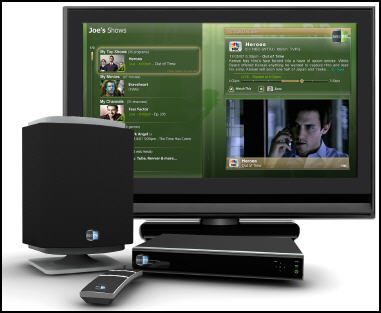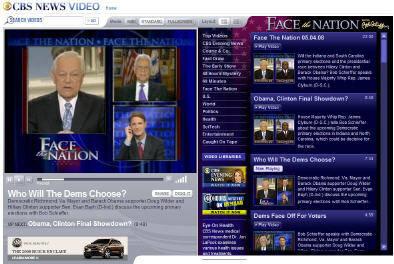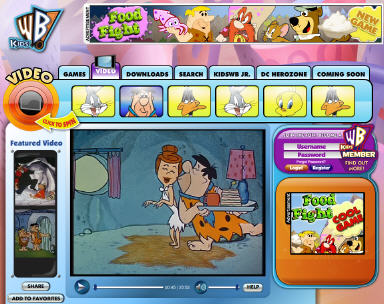-
More Questions than Answers at Digital Hollywood Spring
I'm just back from a couple days at Digital Hollywood Spring, one of the broadband industry's leading conferences. A key takeaway for me is that there are still many more outstanding questions about the broadband video industry's future - and their implications for other players in related industries - than there are concrete answers.
Here are 3 big ones worth considering:
What role will current video distributors play in an increasingly broadband-centric world?
The subscription video business, dominated by cable and satellite operators, generates approximately $80 billion/year, depending on whose data you use. The model is well-understood, and is a huge part of funding the value chain of cable networks, rights-holders and TV program producers. Bundling ever more channels (50,70,100+) into digital tiers and charging ever-higher prices for them has been a core industry revenue driver.
Yet data continues to show that out of all those channels, the average household still only watches 5-10 at the most. Couple that with the migration to broadband, DVR and on-demand consumption and one is left with the feeling that there is a significant disconnect between the way video is packaged and priced today with growing consumer expectations and behaviors. Is the current approach sustainable long term or are new players (e.g. Sezmi) going to successfully disrupt the formula? Any major disruption would have significant ripple effects.
Is the ad-supported business model for broadband video going to deliver for all the content providers relying on it?
I've been a big supporter of the ad-supported approach for a while and believe in it strongly in the long-term. Yet as I see more and more content providers, aggregators, social networks and others look to it as their primary business model, I'm growing concerned that in the short-term there isn't going to be enough money to go around to support everyone. To be sure, current growth rates are strong, yet at DH many of advertising's big hurdles to reach long-term success were mulled over: achieving scale, standardizing formats, understanding performance metrics, converting media buyers, targeting, proving interactivity's value and so on.
The efficacy of the broadband ad model online is particularly pressing for broadcasters. Though some research indicates on-air viewership is benefited from online program availability, long-term there can be no question that a substitution effect will take place as viewers decide "do I watch on-air OR online?"
Jeff Zucker, NBCU's CEO tersely captured the threat this poses in his now often-repeated question "are we trading analog dollars for digital pennies?" In other words, if someone watching an NBC show like The Office on Hulu currently brings NBC far less revenue than if they were watching it on-air, is the migration to broadband viewership actually causing a permanent down-sizing of broadcasters' ad revenue per minute viewed? A scary thought to contemplate.
What does all this mean for Hollywood?
Surely less subscription or ad revenue eventually means less money for everyone including the whole Hollywood apparatus that has been funded out of the traditional models. But how, when and to what extent does this play out?
Further, is the very nature of what's expected of Hollywood changing? Herb Scannell, CEO/founder of Next New Networks asserted in his panel that the current generation of 'auteurs' - multi-skilled and motivated people who can write, direct, produce, act and promote implies a far different role for how Hollywood creates value for itself in the future. In fact, Herb believes that technology-empowered talent is the biggest disruptive force to the traditional Hollywood equation.
The point was brought home to me in a offsite function I attended in which Bebo, the massive youth-oriented social network (recently sold to AOL for $850 million), outlined its big push into original entertainment (e.g. "KateModern," "Sofia's Diary," etc.). Their expectations of what they, creators and users will be doing to create value are starkly different from the Hollywood model.
And the questions continue. There are ample reasons to be enthusiastic about broadband video, still, we are living through transformational times impacting every corner of the traditional video value chain. For now many questions loom. Hopefully more answers will be forthcoming soon.
Do you have any answers? Post a comment and let everyone know!
Categories: Broadcasters, Cable Networks, Cable TV Operators, Devices
Topics: Bebo, Digital Hollywood, Next New Networks
-
2009 Super Bowl Ads to Hit $3 Million, Broadband's Role Must Grow
The Wall Street Journal reported yesterday that NBC will announce next week that the starting price for a 30 second ad during the 2009 Super Bowl will cost $3 million, a 10% increase over 2008. For sure one thing this
 means to me: broadband video's role must grow in order to earn Super Bowl advertisers a return on these outsized rates.
means to me: broadband video's role must grow in order to earn Super Bowl advertisers a return on these outsized rates.As some of you know I've been writing about this topic for the last few years, even preceding the launch of VideoNuze. In Jan '06, in "The $10 Million Super Bowl Ad?" I argued that Super Bowl ad prices were heading nowhere but up given the historic opportunity to fuse the best of brand advertising with the best of online advertising.
I thought the linchpin would be brands recognizing that broadband video elements (e.g. larger campaign narratives, user contests, etc.) should precede and/or follow the game ad, creating a far larger engagement and ROI scenario. With more potential benefits, Super Bowl ad buying would be far less risky and therefore more advertisers would be compelled to buy, thus driving prices up.
While prices have risen, it's been more because audiences have continued fragmenting, making the Super Bowl truly a once-a-year advertising opportunity. NBC's willingness to raise prices by 10% over '08, in the face of a difficult U.S. economy is further testament to the big game's luster.
Back in '06 I forecasted that creative lightbulbs would be going off on Madison Avenue for how to capitalize on broadband's potential to add value. Sadly in the last 2 years this hasn't materialized. In Jan '08, in "My Rant About Super Bowl Ads" I lamented the fact that of the 52 game ads, only 5 (later revised to 6) ads had a broadband component. While the ads themselves were viewed for weeks after in online galleries, the stark reality was that tens of millions of dollars of client ad spending was being dramatically sub-optimized by not incorporating any broadband video elements.
It may be unfair of me to say, but I place the disproportionate share of the blame for this on the agencies behind the Super Bowl ads. They seem oblivious to how their clients' ad strategies must change to reflect broadband and online's importance.
So here's my message to brands considering a Super Bowl '09 ad buy: with 8 full months until game day, if your agency is not presenting you now with at least a half dozen compelling ideas for how to incorporate broadband elements into your Super Bowl ads, switch agencies now. I mean it. They are under-serving you. Find an agency that gets it, not one that is stuck in a time warp. The brands that will really score in the '09 game will have ads that reflect today's broadband realities.
Categories: Advertising, Brand Marketing, Sports
Topics: Super Bowl
-
Sunday Morning Talk Shows Need Broadband Refresh
In the heat of the Democratic primary, the five major Sunday morning talk shows have recently taken on greater prominence. For political junkies like me, even after a week's worth of endless campaign coverage, it is great sport to watch the candidates and their surrogates put the best face on the week's events, while eagerly trying to tee up issues for the coming week's news cycle.
The Sunday shows are also perfect fodder for broadband video consumption. On-air they are neatly segmented by guests and topics, their archives offer a vivid research opportunity for both editorial and user-driven curation, and the audiences that tune in are upscale and appealing to advertisers.
With all this going for them, I decided to investigate the online presence of the five Sunday morning shows, ABC's "This Week with George Stephanopoulos," CBS's "Face the Nation with Bob Schieffer," FOX's "Fox News Sunday with Chris Wallace," NBC's "Meet the Press with Tim Russert" and CNN's "Late Edition with Wolf Blitzer."
Though all of the sites had their strengths, as a group I found them to be surprisingly average initiatives, especially in comparison to the superb efforts these same networks have mounted for their online entertainment programming. (Note that all I found for "Late Edition" was a brochure page)
"FTN" would have to rank at the top of my list, primarily because it segments the show by its guests and topics and displays them in the user-friendliest manner. This allows the user to quickly zero in on desired segments. "This Week" and "MTP" do some of this as well, though I found their presentation not as straightforward. What's missing from all are related clips across episodes curated in a meaningful way. Presentation is very episode-centric.
While all the sites rely heavily on pre-roll ads, "FTN" gets credit for using some frequency capping. "This Week," seems to ignore the best practices that ABC.com follows in presenting its shows with limited interruptions. Not only does it not frequency cap, it also ran the same 2 ads - one for Intel and one for Verizon Wireless - over and over. Needless to say this became tiresome after clicking to watch several segments.
Meanwhile, navigation and available content on these sites are all over the board. "MTP" offers a link to watch the whole program with limited interruptions, while "FNS" offers a text transcript of the most recent program, but not a video of the whole program. "This Week's" main text navigation has links to pure text stories, text stories with embedded video clips, and video clips alone, but no way to sort the list by media type. Search on each site also yields highly diverse results - some video, some not. One missed opportunity is that none offer any user editing features. Putting together your own highlights reel to be embedded on a blog or social networking site would likely be great fun for many hard-core viewers.
The Sunday talk shows offer dynamite content, highly leverageable for broadband consumption. Hopefully as the political season rolls on we'll see the networks recognize this and continue to invest in new features and improved usability.
What do you think? Post a comment and let us all know!
Categories: Broadcasters, Cable Networks
Topics: ABC, CBS, CNN, FOX, NBC
-
iTunes Film Deals Not a Game-Changer
In the last few days there's been a lot of attention paid to Apple's deals with Disney, Fox, Warner Bros, Paramount, Universal, Sony, Lionsgate, Imagine and First Look Studios giving iTunes day-and-date access to these studios' current films.
As an advocate of the broadband medium, naturally I'm delighted to see studios put broadband distribution
 on a par with DVD release. The deals should rightly be interpreted as another step in the maturation of the broadband medium.
on a par with DVD release. The deals should rightly be interpreted as another step in the maturation of the broadband medium. However, these deals, in and of themselves, do not constitute a game-changing event for paid downloads of feature films. That's because until there's mass connectivity between PCs and TVs and much-improved portability, consumers' willingness to buy is going to be significantly muted. Consumers' inability to easily watch a feature film on their widescreen TV or easily grab-these- movies-to-go (as with DVDs) are a huge drag on the download value proposition, easily swamping its new convenience benefits.
I believe that lack of mass connectivity between PCs and TVs is the last major hurdle to unlocking broadband video's ultimate potential. It is also the firewall that's preserving a lot of incumbents' business models (cable operators, broadcasters, etc.). No question, Apple and iTunes are powerful marketing partners for the studios, and their download revenue will certainly increase from its current modest base. But not even Apple's mighty brand (and certainly not its anemic AppleTV device) is enough to compensate for broadband's current deficiency.
The good news is that there's a frenzy of energy directed at solving the PC-to-TV connectivity issue. Though no approach has yet broken through, I'm still betting it's only a matter of time until one does. When that happens, studios will reap the major benefits. Until then, these deals represent progress, but not game-changing events.
Categories: Aggregators, Downloads, FIlms, Studios
Topics: Apple, Disney, FOX, iTunes, Lionsgate, New Line, Paramount, Sony Pictures, Universal, Warner Bros.
-
Anystream Lands Hearst-Argyle and Brings New Competition in Video Management Space
Anystream, a long-time player in video transcoding, is announcing that its Media Lifecycle Platform has been implemented by 11 of Hearst-Argyle's 29 owned and operated TV stations.
The move suggests even more vigorous competition is coming to the video management/publishing space where players like thePlatform, Brightcove, Maven, ExtendMedia, PermissionTV, Akamai (StreamOS), WorldNow and others have focused.
I sat down with Anystream (note, a periodic VideoNuze sponsor) president Bill Holding and founder/chairman Geoff Allen recently to learn more about their expansion strategy.
Anystream is well-known in the digital media space as it Agility transcoding platform is deployed in over 700 companies. Leveraging this base of relationships and its knowledge of customers' work flows, Anystream is
 now "moving north" by focusing on the video management layer. The core technology comes from Anystream's 2007 acquisition of Cauldron Solutions, which has been built out, renamed as Velocity and integrated with Agility.
now "moving north" by focusing on the video management layer. The core technology comes from Anystream's 2007 acquisition of Cauldron Solutions, which has been built out, renamed as Velocity and integrated with Agility. Anystream's new, broader positioning rests on its belief that the video "Produce-Manage-Monetize" lifecycle elements are deeply linked, and that ultimately a comprehensive, integrated solution will be prized by media companies serious about scaling their broadband video businesses. At the manage layer specifically, Velocity focuses on rights, scheduling, packaging, syndication and asset tracking.
Anystream believes metadata it gains access to, at the start of the video lifecycle through its transcoding role, is a unifying value driver in the video management and monetization phases.
Hearst-Argyle clearly saw the benefits of this approach, citing Anystream's metadata management as opening up new content re-use opportunities and creating competitive advantage. In the press release, Joe Addalia, H-A's director of technology projects, said H-A has cut its production and distribution to online channels "from 30 minutes to 3 1/2 minutes."
I continue to be impressed with how many companies are staking a claim in the broadband video management/publishing space. I'm constantly trying to discern the real competitive differentiators that separate industry players. Like many of you, I often find the landscape quite blurry, with overlapping capabilities. Each player tends to cite its traditional competencies as being the best building blocks from which to build a full scale management/publishing platform.
While it's tempting to say "they can't all be right," the fact that so many players are finding market success today indicates that content owners are not monolithic in their specific requirements and that a giant game of matchmaking seems to be occurring between content owners and video management providers. One day there may be a consensus on who truly has the "best" management platform, but for now that day seems to be far off.
What do you think? Post a comment and let us all know!
Categories: Broadcasters, Technology
Topics: Akamai, Anystream, Brightcove, ExtendMedia, Hearst-Argyle, Maven, PermissionTV, thePlatform, WorldNow
-
Sezmi - Building B Portends Major Disruption to TV Industry
Builidng B, the stealthy, well-funded startup I wrote about last December, is at last pulling back the curtain today, unveiling "Sezmi" as its new name and releasing details of its end-to-end system for delivering traditional television programming and broadband video directly to the TV.
I got a preview of Sezmi (pronounced "SaysMe") at a private briefing with company executives at NAB 2 weeks ago. Upfront I want to offer a huge caveat that I only saw the system in demo mode so I cannot vouch for its performance in actual, scale situations. That said, if the system works as described, then I
 would rank Sezmi as the most promising approach I've yet seen for bridging the currently separate worlds of broadband video and TV. Sezmi could well be the first bona fide broadband/on-demand competitor to cable TV and satellite operators.
would rank Sezmi as the most promising approach I've yet seen for bridging the currently separate worlds of broadband video and TV. Sezmi could well be the first bona fide broadband/on-demand competitor to cable TV and satellite operators.First things first. Sezmi should not be confused with broadband appliances seeking to bridge broadband and TV, such as AppleTV, Vudu, Akimbo and others. I am an avowed skeptic of all of these. Sezmi does not focus on delivering broadband video as an add-on to existing cable/satellite subscriptions. Rather, it is looking to replace these providers by combining the best of the traditional linear broadcast/cable network model with broadband, on-demand, digital video recording, personalization, social networking and ease-of-use that many of us now consider second nature.
Sezmi is a complete system, providing an antenna, set-top box and remote control to the consumer. One of Sezmi's key innovations is "FlexCast," which leverages multiple delivery networks to get broadcast/cable channels and broadband video into the home. In fact, the traditional channels are the bedrock of Sezmi's service offering, enabling it to be a true competitor to incumbent video providers. Sezmi leases digital broadcast space from local stations to efficiently deliver these channels, which can be watched in either familiar linear mode, or in recorded on-demand mode (note the initial set-top box comes with 1 terabyte of storage, soon to be 2 terabytes). For broadband video, it makes use of the existing broadband ISP connection.

 Sezmi creates an entirely new, and exciting user experience that digital media enthusiasts will instantly recognize, and I believe, value. These include the remote control with an iPod-like scroll wheel, no numeric keypad and one-touch personalization for family members. There is also the on-screen navigation, which groups shows by episode, and presents them in personalized home page-like settings. And there's targeted contextual advertising, allowing familiar click-through options.
Sezmi creates an entirely new, and exciting user experience that digital media enthusiasts will instantly recognize, and I believe, value. These include the remote control with an iPod-like scroll wheel, no numeric keypad and one-touch personalization for family members. There is also the on-screen navigation, which groups shows by episode, and presents them in personalized home page-like settings. And there's targeted contextual advertising, allowing familiar click-through options.Recognizing that a direct-to-consumer approach would be costly and slow to scale, Sezmi has adopted a partner-centric go-to-market strategy. It is working with ISPs, telcos and others who seek entry to the video services business. Buno Pati, Sezmi's CEO/co-founder told me he expects consumer pricing would be approximately half of today's digital cable tier, including HD and DVR capability. I suggested that might imply a $35-40 per month fee. While not confirming that number, he said he wouldn't disagree with my estimate.
If Sezmi can work out its economics with partners and deliver that pricing to consumers, it would be a very compelling alternative to today's cable/satellite offerings. The key is to whom? In my briefing many types of customers were mentioned: analog subscribers, new HD TV purchasers, over-the-air households, and others. Given how ground-breaking it service is, in my opinion Sezmi needs to go after digitally savvy audiences first.
Today the company is announcing only that it is commencing trials in pilot markets and expects commercial launch with partners later this year. All eyes will be on Sezmi to see if it can execute on its bold vision. If it does this is a company that has major disruptive potential.
(Note - very coincidentally, Sezmi CEO/co-founder will be on my Digital Hollywood panel next Wed, May 6th at 10:45am)
Categories: Cable TV Operators, Devices, Startups
Topics: Building B, SezMi
-
Gotuit Launches Video Metadata Authoring Tool
Gotuit, whose technology allows for indexing longer-form content into individual scenes based on their metadata, is today announcing "VideoMarker Pro." This gives content providers the choice of indexing their video themselves, rather than relying on a service relationship with Gotuit, as customers like SI, Major League Soccer, Fox Reality and others traditionally have.
As I wrote last November, I've been very bullish about broadband's ability to create searchable segments
 carved out of longer-form programming. A perfect example of this is what TheDailyShow.com has done, offering 19,000+ clips from all of the show's episodes. Searchable clips create a powerful new user experience leading to more video consumed. This in turn means more ad inventory which is also ripe for contextual targeting.
carved out of longer-form programming. A perfect example of this is what TheDailyShow.com has done, offering 19,000+ clips from all of the show's episodes. Searchable clips create a powerful new user experience leading to more video consumed. This in turn means more ad inventory which is also ripe for contextual targeting.The big problem with creating searchable clips has been that without the proper tools it would be painfully time-consuming. Worse is that a large library would spawn thousands of clips that would need to be managed. While TheDailyShow.com took the plunge, others have been reluctant, thereby leaving a lot of highly monetizable longer-form video locked in its original state.
Enter VideoMarker Pro. Last week, Patrick Donovan, Gotuit's VP of Product Management, demonstrated for me how a show such as "Lost" would be indexed.
The starting point is for a producer to set up the show's "Attributes" or key descriptors, based on how users might be expected to search (e.g. by character, plot line, topic, funniest lines, etc.) for specific clips. Once done, the show plays in a side panel while the editor uses the tools to mark "Time-In" and "Time-Out" points, and to assign attributes to that scene. Once a scene is marked up, the editor clicks save and quickly moves on to the next one.
The whole process is dead-simple, enabling an intern or offshore partner to crank out clips quickly and accurately. Patrick estimates the whole indexing process takes 25-30% of real time (e.g. a typical 1 hour show running 44 minutes would take less than 15 minutes to index.) When you do the math, you realize it would be ridiculously cheap to index an entire season or even multiple seasons. (This is particularly relevant given the recent emphasis on offering classic TV content online - see yesterday's Warner Bros post as an example.)
There are multiple ways to present the index, using thumbnails, playlists and search. In fact VideoMarker Pro is actually creating "virtual" clips by sending an XML message to the CDN with instructions to play the video at its specified time points. This creates a lot of flexibility, especially for syndicating clips to partners. There's no clip inventory to manage, transfer and update.
VideoMarker Pro is another example of how the technologies sprouting up around broadband video allow content providers to extract ever-growing value from their original investments.
What do you think? Post a comment and let everyone know!
(Disclaimer - I have a very minor advisory role with Gotuit)
Categories: Technology
Topics: Gotuit, TheDailyShow.com, VideoMarker Pro
-
New Warner Bros' Sites Showcase Broadband's Abundance
The news yesterday that Warner Bros Television Group plans to launch TheWB.com as an online outlet to offer its catalog of popular programs and KidsWB.com to house its animated favorites are further reminders that broadband's infinite shelf space creates all kinds of new opportunities for broadcasters and studios ready to experiment and be creative.
I regard these moves as the latest evidence that industry players are beginning to understand how programming in a broadband world differs from business-as-usual approaches. If there is one word that captures the essence of the traditional world it would be "scarcity." Scarcity of time slots, distributors, eyeballs, financing, brands, advertising dollars, ideas, etc. The whole broadcasting and studio paradigm is built on a zero sum - and legitimate - idea that only a very small handful of all creative pursuits can succeed at any one time.
Broadband explodes the scarcity model, introducing a world of abundance in which every scarcity constraint is alleviated or erased. Abundance thinking has guided online retailers for years: offering incremental inventory is dirt-cheap, and if made easily discoverable, it will find its buyers. In fact, as the incongruous popularity of "Arrested Development" on Hulu already shows, latent demand for catalog programming can actually be quite strong.
Evidence is growing that other video providers also understand the abundance concept. Recently other networks and studios have also launched their own efforts to monetize catalog programming. At my recent NAB panel, the head of CTV's 2012 Olympics coverage noted that ALL Olympic activity will be available for online viewing (their mantra is "Every Second Counts"). Also at NAB, I was introduced to a stealthy new initiative to make available high-quality archived video that has never been available online. I expect plenty more examples to come.
To be sure, broadband's abundance creates all kinds of new challenges: More audience fragmentation. New promotion and user navigation issues. More monetization complexity. New operational and management tasks. And so on.
Yet broadband's abundance should be viewed as a direct challenge to the historical scarcity model on which broadcasters' and studios' strategies have long been built. Industry participants who recognize the new world order and embrace it will be best-positioned to succeed.
What do you think of how broadband's abundance changes things? Post a comment and let everyone know!
Categories: Broadcasters, Studios
Topics: KidsWB.com, TheWB.com, Warner Bros




